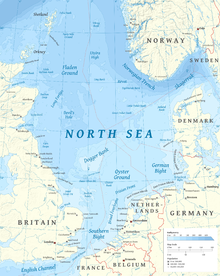Silver Pit
- Or see Outer Silver Pit, another deep place in the North Sea.
- Or see silver mining.
The Silver Pit is a long valley in the bed of the North Sea, 45 km (28 mi) east of Spurn Head in England. At some point in time the Silver Pit was part of the valley of the Wash River [citation needed].
Also notable is the Silverpit crater, a crater-like feature near the Silver Pit, discovered in 2002.
Origin of the Silver Pit
[edit]In origin, it is probably a tunnel valley (Benn & Evans fig.9.27) which was kept free of periglacial deposits by the Wash River when the sea level was lower, towards the end of the Devensian glaciation. However, the Silver Pit may date partially or largely from the Wolstonian Stage.
The Silver Pit (or Silver Pits) was discovered in the 19th century by trawler fishermen from the South Coast of England. They found the small valley to be rich in flatfish, especially soles in winter.[1]
See also
[edit]- Dogger Bank for map and links to similar places
- Doggerland
- Timeline of glaciation
- Inner and Outer Dowsing sand banks
References
[edit]- ^ Uglow, R F (1991). "13: Yorkshire Fisheries". In Lewis, David (ed.). The Yorkshire coast. Beverley: Normandy Pr. p. 180. ISBN 0-9507665-3-4.
- Benn, D.I. & Evans, D.J.A. Glaciers and Glaciation (1998) ISBN 0-340-58431-9
- Cameron, Crosby, Balson, Jeffery, Lott, Bulat & Harrison. The Geology of the Southern North Sea (1992) ISBN 0-11-884492-X
- Glennie, K.W. Lower Permian - Rotliegend in ed. Glennie Introduction to the Petroleum Geology of the North Sea. (1990) ISBN 0-632-02711-8
- Imray, Laurie, Norie & Wilson pub. East Coast of England: Orfordness to Blythe marine chart (1980)
External links
[edit]- Silver Pit chart The Outer Silver Pit is further to the north-east, at the eastern end of the Skate Hole.
- Outer Silver Pit chart It lies between the Dogger Bank and the Norfolk to Friesland ridge.

